Pete Conrad Global Patient Safety Award
The Pete Conrad Global Patient Safety Award was established in honor of Charles "Pete" Conrad Jr., the Apollo 12 astronaut who was the third man on the moon.[1] The award was established by his widow, Nancy Conrad and is awarded to health care leaders, caregivers, educators, students, and institutions.
| Pete Conrad Global Patient Safety Award | |
|---|---|
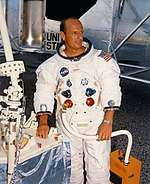 | |
| Awarded by Nancy Conrad | |
| Status | Active |
| Statistics | |
| Established | 2007 |
| First awarded | 2007 |
| Last awarded | 2018 |
| Total awarded | 25 |
Winners of the award include former healthcare government agency leaders involved in performance improvement initiatives, astronauts who championed patient safety after their tour with NASA, quality and security leaders of large hospital systems, nurses, patient advocates, elementary school teachers, and students.
Background
After Pete Conrad died the preventable death of a systems failure in emergency care following a low speed motorcycle accident with a delay in diagnosis[2] and treatment, Nancy Conrad, his widow, set out on a quest to help save lives of patients and victims of similar scenarios.[3] She co-founded the Community Emergency Healthcare Initiative and spoke at global meetings to enlist the help of patient safety experts around the world.[4]
Nomination and selection
The award is given for extraordinary contributions to patient safety and is not an annual award. Nancy Conrad makes the final decision on awardees with input from expert advisors from the healthcare, aerospace, and the innovation communities.
Recipients
2007 Award Recipients
In 2007, the award was given to the organizations that participated in the harmonization effort that lead to the development of the 2006 National Quality Forum Safe Practices for Better Healthcare. This harmonization effort was the first ever synchronization of best practices across suppliers, providers, and purchasers of healthcare. It allowed healthcare institutions to focus on a common set of impact targets. The award was received on behalf of the organizations by their leaders.
2012 Award Recipients
At a TMIT global safety summit in 2012, the award was given to individuals representing organizations that had made enormous contributions to patient safety. They included contributions through national best practices, measures, and standards harmonization that allowed hospitals to target a common set of metrics. This resulted in many thousands of lives and millions of dollars being saved in U.S. healthcare.[5] The awards were presented Nancy Conrad,[6] widow of Pete Conrad; and former Congressman Dana Rohrabacher (R-CA) at the National Press Club in Washington, D.C.[7]
2014 Award Recipients
In 2014, the award was given to a group of national consumer advocates. These individuals have written and published peer-reviewed medical articles[8] and co-authored portions of The National Quality Forum Safe Practices for Better Healthcare.[9] They were honored for their perseverance in championing the cause of patient safety for over a decade. Their contribution to passage of the Hospital Acquired Conditions (HACs) by the U.S. federal government that tied financial incentives to patient safety has generated savings of more than $2.9B and saved more than 8,000 lives.[5][10][11][12]
2018 Award Recipients
The 2018 award winners include individuals and a team. Sorrel King, Sue Sheridan, and Heather Foster were awarded as individual patient safety champions who have exhibited the courage, faith, and tenacity to speak truth to power on behalf of patients after tragic deaths and harm to families. The Med Tac Training team was honored for their role in empowering bystanders to deliver lifesaving patient safety assistance in their communities before professional first responders arrive and then to work with professional caregivers during pre-hospital care.
| Photo | Name | Date | Awarded for | References |
|---|---|---|---|---|
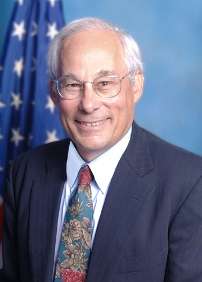 |
Donald Berwick | 2007 | Dr. Donald Berwick was the President and CEO of the Institute for Healthcare Improvement (IHI) in 2007 when he received the Pete Conrad Global Patient Safety Award on behalf of the IHI for its role in harmonizing the National Quality Forum Safe Practices for Better Healthcare with the other award winners. He launched the 100,000 Lives Campaign and the 5 Million Lives Campaign paving the way for national performance improvement in patient safety. President Obama later appointed him as the administrator of the U.S. Centers for Medicare and Medicaid Services.[13] He has been awarded Honorary Knight Commander of the Most Excellent Order of the British Empire in recognition for his global contributions.[14] | [15][16] |
 |
Carolyn Clancy | 2007 | Dr. Carolyn Clancy was the Director of the U.S. Agency for Healthcare Research and Quality (AHRQ), and Clinical Associate Professor at George Washington University School of Medicine at the time she received the Pete Conrad Global Patient Safety Award on behalf of AHRQ for its role in harmonizing national safe practices with the other award 2007 winners.[17] AHRQ provided critical help in establishing the National Quality Forum Safe Practices for Better Healthcare. | [15][16] |
 |
Janet Corrigan | 2007 | Janet Corrigan was the President and CEO of The National Quality Forum (NQF) when she received the Pete Conrad Global Patient Safety Award on behalf of the NQF for its role in facilitating the harmonization of the National Quality Forum Safe Practices for Better Healthcare with the other 2007 award winners who agreed to synchronize their measures with them.[18] She was formerly a leader at the Institute of Medicine and helped author the nationally impactful report To Err is Human: Building a Safer Health System[19] which helped launch the national patient safety movement.[20] | [15][16] |
 |
Peter Angood | 2007 | Dr. Peter Angood was the Chief Patient Safety Officer and a Vice President for The Joint Commission (TJC), overseeing annual development of TJC’s National Patient Safety Goals and other enterprise-wide patient safety initiatives, when he was awarded. He received the Pete Conrad Global Patient Safety Award on behalf of The Joint Commission for its role in harmonizing national safe practices with the other 2007 award winners. | [15][16] |
 |
Suzanne Delbanco | 2007 | Suzanne Delbanco was the first Executive Director of The Leapfrog Group and led the collaborative development of the strategies for reporting of safety to America's employers. She was directing The Leapfrog Group at the time she received the Pete Conrad Global Patient Safety Award on behalf of the organization for their work with the other 2007 award winners.[21] The Leapfrog Group used the harmonized practices to lead the pay-for-performance movement on behalf of employers and consumers.[22][23] | [15][16] |
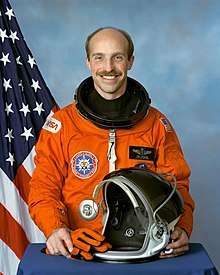 |
James Bagian | 2012 | Dr. James Bagian, a former NASA Space Shuttle astronaut, physician, and engineer served as the first Director of the VA National Center for Patient Safety (NCPS) and the first Chief Patient Safety Officer for the Department of Veterans Affairs from 1999 to 2010, where he developed numerous patient safety-related tools and programs that have been adopted nationally and internationally.[24][25] He received the Pete Conrad Global Patient Safety Award for his global contribution to patient safety in many areas through his application of engineering principles to quality improvement. He is the Director of the Center for Healthcare Engineering and Patient Safety and is a Professor in the Medical School and the College of Engineering at the University of Michigan.[24] | [15][26][27] |
 |
J. Michael Henderson | 2012 | Dr. Michael Henderson, a former transplant surgeon, was the Chief Quality Officer at the Cleveland Clinic[28] when he received the Pete Conrad Global Patient Safety Award for his global contributions to patient safety including those through the World Health Organization,[28] collaboration on Discovery Channel documentaries, and harmonization of best practices across other world leading institutions. Henderson is currently the Chief Medical Officer at the University of Mississippi Medical Center where he has developed a High-Reliability Program.[29] | [15][26][27] |
 |
David Classen | 2012 | Dr. David Classen is Chief Medical Information Officer (CMIO) at Pascal Metrics in Washington, DC.[30] He received the Pete Conrad Global Patient Safety Award for his global contributions to patient safety in infectious disease, health information technology, and the NQF Safe Practices for Better Healthcare. He was formerly the Chief Medical Officer (CMO) and a Vice Senior Partner at Computer Sciences Corporation (CSC) and led CSC's safety and quality of healthcare initiatives.[31][32] | [15][26][27] |
 |
Stephen Swensen | 2012 | Dr. Stephen Swensen served as the Mayo Clinic Director for Quality when he received the Pete Conrad Global Patient Safety Award for his global contributions to patient safety including the harmonization of the NQF Safe Practices for Better Healthcare,[33] protection of children from excessive ionizing radiation from computed tomography (CT Scans),[34] and contributions to the 5 Rights of Imaging message platform. He was formerly Professor and Chair of Radiology and Director for Leadership and Organization Development at the Mayo Clinic. He is a global expert on caregiver burn out and joy at work. | [15][26][27] |
 |
David Hunt | 2012 | Dr. David Hunt served as a Medical Officer at the Office of the National Coordinator for Health Information Technology when he received the Pete Conrad Global Patient Safety Award for his national contributions to patient safety, leadership in prevention of surgical site infections, and contributions to the development and refinement of the National Quality Forum Safe Practices for Better Healthcare.[35][36][37] | [15][26][27] |
 |
Dan Ford | 2014 | Dan Ford is a former healthcare executive and global patient safety advocate. He became a national champion for inviting patients and families into Root Cause Analyses after a member of his family suffered a patient safety accident.[8] He and the other 2014 award recipients have worked on a number of national quality committees, were major contributors to multiple national patient safety programs,[9] and have been credited for helping pass the Hospital Acquired Conditions (HACs) which as of 2018 the government reports to have saved $2.9B and 8,000 lives.[5] | [15][26] |
 |
Arlene Salamendra | 2014 | Arlene Salamendra is a global patient safety advocate who is a former board member and staff coordinator of Families Advocating Injury Reduction (FAIR).[38] She is a consumer expert on workplace bullying and safety of patients. She received the award for her years of advocacy, co-authorship of important patient safety articles in peer-reviewed literature,[8][9] and her contribution to passage of the Hospital Acquired Conditions (HACs) generating savings in the billions of dollars and thousands of lives saved with the other 2014 winners.[5] | [15][26] |
 |
Becky Martins | 2014 | Becky Martins is an award-winning global patient safety advocate who founded Voice4Patients.com, an initiative to empower patients to be their own health care advocates. Well known in her state of Maine and nationally for her leadership, she received the award for her years of advocacy, co-authorship of important patient safety articles in peer-reviewed literature,[8][9] and her contribution to passage of the Hospital Acquired Conditions (HACs) generating savings in the billions of dollars and thousands of lives saved with the other 2014 winners.[5] | [15][26] |
 |
Jennifer Dingman | 2014 | In 1995, Jennifer Dingman founded Persons United Limiting Sub-standards and Errors in Healthcare (PULSE), a national organization and platform to support patients and their families who have experienced medical errors and other adverse medical outcomes. She championed the cause of using the patient story as a major change agent to impact healthcare providers.[39] She has served on multiple national patient safety programs. She received the award for her years of advocacy, co-authorship of important patient safety articles in peer-reviewed literature,[8][9] and her contribution to passage of the Hospital Acquired Conditions (HACs) generating savings in the billions of dollars and thousands of lives saved with the other 2014 winners.[5] | [15][26] |
 |
Mary Foley | 2014 | Mary E. Foley, PhD, RN, FAAN is a past president of the American Nurses Association. She is a Clinical Professor at the University of California San Francisco (UCSF) School of Nursing and is the Director in the Center for Nursing Research and Innovation at UCSF. She received the award for her years of educating nurses and consumers, advocacy, co-authorship of important patient safety articles in peer-reviewed literature,[8][9] and her contribution to passage of the Hospital Acquired Conditions (HACs) generating savings in the billions of dollars and thousands of lives saved with the other 2014 winners.[5] | [15][26] |
 |
Patti O'Regan | 2014 | Patti O’Regan is a Nurse Practitioner who developed the first medical errors and patient safety module incorporated into an undergraduate course curriculum in the U.S. She received the award for her years of educating nurses and consumers, advocacy, co-authorship of important patient safety articles in peer-reviewed literature,[8][9] and her contribution to passage of the Hospital Acquired Conditions (HACs) generating savings in the billions of dollars and thousands of lives saved with the other 2014 winners.[5] | [15][26] |
 |
Sorrel King | 2018 | Sorrel King is the founder of the Josie King Foundation which was created in honor of her 18-month-old who died of medical errors at Johns Hopkins Medical Center.[40] An author, national speaker, and patient safety advocate, she received the 2018 Pete Conrad Patient Safety Award for her vigilant contributions to healthcare for more than a decade. A peer-reviewed study showed that a video of her sharing the story of the death of her child and her call to action saved more than 675 lives in individual hospitals where it is regularly seen.[41] The video prompted Ascension Health to undertake a program that saved thousands of lives.[42] | [15] |
 |
Susan Sheridan | 2018 | Sue Sheridan is a global patient safety leader who has turned preventable tragedy to triumph by using the severe harm to her son and the death of her husband to save lives around the world. She rallied more than 90 mothers to develop and bring about a Joint Commission Sentinel Event saving babies from kernicterus and brain damage that her son experienced.[43][44] She has led WHO programs and was appointed the Director of Patient Engagement for PCORI, the Patient-Centered Outcomes Research Institute. She has been a Patient & Family Engagement Advisor for the Centers of Medicare and Medicaid. She is the Director of Patient Engagement with the Society to Improve Diagnosis in Medicine.[45] | [15] |
 |
Heather Foster | 2018 | Heather Foster is a practicing nurse and national leader championing the cause of caregivers after medical error. She receives the Pete Conrad Global Patient Safety Award for her steadfast support of speaking truth to power, for championing patient safety at great personal risk, and for representing the masses of frontline caregivers who need support when they stand up for their patients. She is an expert advisor to The Healthcare Innocence Project, a program to support whistleblowers and caregivers in patient safety. | [15] |
 |
Gregory H. Botz | 2018 | Dr. Gregory Botz is a Professor of Anesthesiology and Critical Care at The University of Texas MD Anderson Cancer Center, the Medical Director for the U.T. Police Department at Houston, and an Adjunct Clinical Associate Professor of Anesthesia at Stanford University Medical School. He inspired the Med Tac team to focus originally on active shooter events.[46] He conceived the CARE Huddle Checklist for bystander care,[46] pioneered the Med Tac Aviation program,[47] and has been the lead train-the-trainer instructor for the Med Tac Program. The Pete Conrad Global Patient Safety Award recognizes his clinical leadership contributions to the Med Tac Program and his leadership service to the team. | [15] |
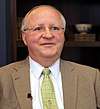 |
William H. Adcox | 2018 | Chief William H. Adcox is a global leader in threat safety science and organizational health security. He helped the Med Tac team target the top eight causes of preventable death.[48] He led development of the Med Tac Law Enforcement program as the Chief Security Officer at the MD Anderson Cancer Center.[47] He is a published author in Campus Safety Magazine and is a Med Tac R&D expert.[46] The Pete Conrad Global Patient Safety Award recognizes his contribution to the lifesaving Med Tac Program and his leadership service in threat safety science. | [15] |
 |
David Beshk | 2018 | David Beshk is an award-winning educator,[49][50] Eagle Scout, and lead educator and pioneer in development of the Med Tac After School and Summer School programs.[46] He was responsible for the first life saved through Med Tac before the first class graduated.[46] He is a 2018 Pete Conrad Global Patient Safety Award winner for his role as an educator and scientific expert in developing the program for educators, schools, and scout groups. | [15] |
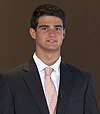 |
Perry Bechtle, III | 2018 | Perry S. Bechtle, III is a college student at the University of Florida, an Eagle Scout, and the leader of the Med Tac Certificate Course program for scouts and college students.[47] He was the first Med Tac Master Instructor in the country and has extensive experience in ocean rescue.[46] He is a 2018 Pete Conrad Global Patient Safety Award winner for his role in the development of the College Med Tac Curriculum having founded and launched the Med Tac Program at the University of Florida. | [15] |
| Charles Denham, III | 2018 | Charlie Denham, III is a middle school student and boy scout. He is a co-founder of the Med Tac program.[46] He and his father developed and refined the program by verifying that children can learn about high impact care hazards and bystander lifeline behaviors. He is co-founder of the Lifeguard Surf program, and as a PADI certified rescue diver, he helped develop the Med Tac Diver Program.[47] He is a 2018 Pete Conrad Global Patient Safety Award winner for co-founding Med Tac and for his role in helping pioneer the program for schools, churches, and scout groups. | [15] | |
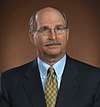 |
Charles Denham, II | 2018 | Dr. Charles Denham is a global leader in patient safety, a retired physician and co-founder, developer, and original funder of the Med Tac Training Program. He has had academic appointments at the Harvard Medical School and the Harvard School of Public Health. He has been an adjunct Professor of Health Systems Engineering at Mayo Clinic College of Medicine. He developed the free Med Tac business model, the CareUniversity learning management system, and “Good Samaritan" insurance protection strategies for schools, churches, and scout groups for bystander care. He is a team member with the other 2018 award winners recognized for their role in pioneering the Med Tac Program for schools, churches, and scout groups. | [15] |
References
- "Astronaut Bio: Charles Conrad, Jr". www.jsc.nasa.gov. Retrieved 2018-12-17.
- WOLCOTT, HOLLY J.; WILSON, TRACY (1999-07-09). "Charles 'Pete' Conrad, 3rd Man on Moon, Dies After Motorcycle Crash". Los Angeles Times. ISSN 0458-3035. Retrieved 2018-12-17.
- Epting, Chris. "In the Pipeline: Pushing for change after tragedy". latimes.com.
- Nancy., Conrad (2005). Rocket man : astronaut Pete Conrad's incredible ride to the moon and beyond. Klausner, Howard. New York, N.Y., USA: New American Library. ISBN 978-0451215093. OCLC 57311427.
- "Declines in Hospital-Acquired Conditions Save 8,000 Lives and $2.9 Billion in Costs". www.ahrq.gov. 2018-06-05. Retrieved 2018-12-17.
- CareUniversity, Nancy Conrad - Pete Conrad Award Presentation - April 27, 2012, retrieved 2018-12-17
- CareUniversity, Dana Rohrbacher - Pete Conrad Award Presentation - April 27, 2012, retrieved 2018-12-17
- Denham, Charles R.; Dingman, Jennifer; Foley, Mary E.; Ford, Dan; Martins, Becky; O'regan, Patti; Salamendra, Arlene (2008-09-01). "Are You Listening...are You Really Listening?". Journal of Patient Safety. 4 (3): 148–161. doi:10.1097/PTS.0b013e318184db52. ISSN 1549-8417.
- "Safe Practices for Better Healthcare–2009 Update". www.qualityforum.org. March 2009. Retrieved 2018-12-18.
- "AHRQ National Scorecard on Hospital-Acquired Conditions Updated Baseline Rates and Preliminary Results 2014–2016" (PDF). www.ahrq.gov. Retrieved 2018-12-17.
- "Saving Lives and Saving Money Hospital-Acquired Conditions Update| Agency for Healthcare Research & Quality". www.ahrq.gov. 2016-12-13. Retrieved 2018-12-17.
- Carter, David (2016). "Wolters Kluwer Health - Article Landing Page". American Journal of Nursing. 116 (3): 17. doi:10.1097/01.naj.0000481268.38697.c6. PMID 26914040.
- Pear, Robert (2010-03-27). "Obama Chooses Health Policy Scholar as the Director for Medicare and Medicaid". The New York Times. ISSN 0362-4331. Retrieved 2018-12-17.
- "Harvard Health Expert Knighted | News | The Harvard Crimson". www.thecrimson.com. Retrieved 2018-12-17.
- Kemp, Kyle. "Prior Recipients". Pete Conrad Global Patient Safety Award. Retrieved 12 December 2018.
- "TMIT". www.safetyleaders.org. Retrieved 2018-12-17.
- Roberts, William (19 April 2006). "CAROLYN MAUREEN CLANCY, MD: a conversation with the editor". Proceedings (Baylor University. Medical Center). 19 (2): 144–147. doi:10.1080/08998280.2006.11928149. PMC 1426182. PMID 16609742.
- Wachter, Robert (April 1, 2010). "In Conversation with…Janet Corrigan, PhD, MBA". AHRQ. Retrieved December 18, 2018.
- Institute of Medicine (US) Committee on Quality of Health Care in America (2000). Kohn, Linda T.; Corrigan, Janet M.; Donaldson, Molla S. (eds.). To Err is Human: Building a Safer Health System. Washington (DC): National Academies Press (US). ISBN 9780309068376. PMID 25077248.
- "Few hospitals improve workplaces, harming patient care". Modern Healthcare. 2018-11-05. Retrieved 2018-12-18.
- Scarrow, Pamela K.; White, Susan V. (September 2009). "Interview with a Quality Leader: Suzanne F. Delbanco on The Leapfrog Group and Employer Purchasing Power". The Journal for Healthcare Quality (JHQ). 26 (5): 18–21, 28. doi:10.1111/j.1945-1474.2004.tb00516.x. ISSN 1062-2551. PMID 15468651.
- Delbanco, Suzanne F. (September 26, 2004). "Suzanne F. Delbanco on the Leapfrog Group and employer purchasing power. Interview by Pamela K. Scarrow". Journal for Healthcare Quality. 26 (5): 18–21, 28. doi:10.1111/j.1945-1474.2004.tb00516.x. ISSN 1062-2551. PMID 15468651.
- "Leapfrog Group Survey Reveals 87 Percent of U.S. Hospitals Dont Take Recommended Steps to Prevent Avoidable Infections". Infection Control Today. 2017-11-22. Retrieved 2018-12-18.
- "James Bagian" (PDF). cheps.engin.umich.edu. Retrieved 2018-12-18.
- "Safety Engineering Meets Patient Safety via Physician Who's Been to Space | patient safety, quality, patient experience | HealthLeaders Media". www.healthleadersmedia.com. Retrieved 2018-12-18.
- "Pete Conrad Patient Safety Award". www.globalpatientsafetyforum.org. Retrieved 2018-12-17.
- CareUniversity, Chuck Denham - Pete Conrad Award Presentation - April 27, 2012, retrieved 2018-12-17
- Henderson, J. Michael (Feb 2016). "Lessons Learned on a Journey from Surgeon to Chief Quality Officer". The Joint Commission Journal on Quality and Patient Safety. 42 (2): 92–95. doi:10.1016/s1553-7250(16)42011-8. ISSN 1553-7250. PMID 26803038.
- "UMMC Steadily Improving Patient Safety Latest Leapfrog Scorecard Shows". Clarion Ledger. April 24, 2018. Retrieved December 18, 2018.
- "Pascal Metrics names Classen CMIO". Modern Healthcare. Retrieved 2018-12-18.
- "David C. Classen, M.D." (PDF). docs.house.gov. Retrieved 2018-12-18.
- Classen, David C.; Resar, Roger; Griffin, Frances; Federico, Frank; Frankel, Terri; Kimmel, Nancy; Whittington, John C.; Frankel, Allan; Seger, Andrew (2011-04-01). "'Global Trigger Tool' Shows That Adverse Events In Hospitals May Be Ten Times Greater Than Previously Measured". Health Affairs. 30 (4): 581–589. doi:10.1377/hlthaff.2011.0190. ISSN 0278-2715. PMID 21471476.
- "Stephen Swensen - Theme Leader for NEJM Catalyst Leadership". NEJM Catalyst. Retrieved 2018-12-18.
- Swensen, Stephen J.; Duncan, James R.; Gibson, Rosemary; Muething, Stephen E.; Lebuhn, Rebecca; Rexford, Jean; Wagner, Carol; Smith, Stephen R.; Demers, Becky (2014-09-01). "An Appeal for Safe and Appropriate Imaging of Children". Journal of Patient Safety. 10 (3): 121–124. doi:10.1097/PTS.0000000000000116. ISSN 1549-8417. PMID 24988212.
- "David Hunt, M.D., F.A.C.S." (PDF). www.tcbi.org. Retrieved 2018-12-18.
- "Hunt, David, M.D." Modern Healthcare. 2007-02-07. Retrieved 2018-12-18.
- "office of the national coordinator for health it | Journal of AHIMA". Retrieved 2018-12-18.
- Reduction, Arlene SalamendraOrganizer, Families Advocating Injury. "PROTECTING PATIENTS". chicagotribune.com. Retrieved 2018-12-18.
- Sheridan, Sue; Conrad, Nancy; King, Sorrel; Dingman, Jennifer; Denham, Charles R. (2008-03-01). "Disclosure Through Our Eyes". Journal of Patient Safety. 4 (1): 18–26. doi:10.1097/PTS.0b013e31816543cc. ISSN 1549-8417.
- Niedowski, Erika. "How medical errors took a little girl's life". baltimoresun.com. Retrieved 2018-12-17.
- Quaid, Dennis; Thao, Julie; Denham, Charles R. (2010-03-01). "Story Power: The Secret Weapon". Journal of Patient Safety. 6 (1): 5–14. doi:10.1097/PTS.0b013e3181d23231. ISSN 1549-8417. PMID 22130297.
- Langreth, Robert. "Fixing Hospitals". Forbes. Retrieved 2018-12-17.
- "From tragedy to advocacy". Modern Healthcare. 2009-09-04. Retrieved 2018-12-18.
- "JCAHO issues warning on kernicterus danger | 2001-07-01 | AHC Media: Continuing Medical Education Publishing". www.reliasmedia.com. Retrieved 2018-12-18.
- "Q&A with Sue Sheridan: Person and Family Engagement". Quality Improvement Organizations. 2017-09-29. Retrieved 2018-12-18.
- "How Bystanders Can Use Med Tac Training to Save Lives". Campus Safety Magazine. 2018-11-26. Retrieved 2018-12-18.
- "Med Tac Specialty Programs Target Specific Environments". Campus Safety Magazine. 2018-11-26. Retrieved 2018-12-18.
- "8 Most Common Preventable Health Hazards". Campus Safety Magazine. 2018-11-26. Retrieved 2018-12-18.
- "The Top 25 Teachers of Orange County 2017". parentingoc.com. Retrieved 2018-12-17.
- "Parenting OC magazine honors local educators at inaugural Top Teacher Reception". OCDE Newsroom. 2017-02-21. Retrieved 2018-12-17.